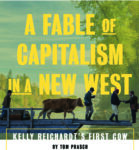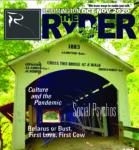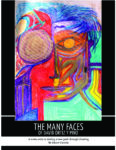Kelly Reichardt’s First Cow
By Tom Prasch
[editor’s note: The IU Cinema hosted Kelly Reichardt in 2016. Her new film, First Cow, is streaming on Netflix.]As King-Lu, the well-traveled Chinese immigrant (he tells tales of London and Egypt and Canton), leads Cookie, the chef who saved him from pursuing Russians (“I might have killed one of their friends,” King-Lu ambiguously confessed earlier), back to his cabin a mile distant from the territorial fort that marks the early creep of civilization into Oregon territory, to share a bottle (but Cookie will end up staying, a partner and ally at the margins), stopping now and then along the way to pluck squished squirrels from his primitive traps (rocks balanced over twigs, waiting to crash down on whatever passes), he waxes philosophical, as he tends to do: “I see something in this land I haven’t seen before. Pretty much everything has been touched by man. But this is still new. More nameless things around here than you can shake an eel at.” Cookie doesn’t quite see things that way: “Doesn’t seem new to me. Seems old.” “Well, everything’s old,” King-Lu concedes, “if you look at it that way.”
But King-Lu is not about to let that interfere with his vision: “History isn’t here yet. It’s coming, but we got here early this time. Maybe this time we can be ready for it. We can take it on our own terms.” Dreams of beating history, filmmaker Kelly Reichardt argues in First Cow, are what Western settlement is made of. And such dreams, she notes as well, albeit wryly, with a comic sensibility, with deep empathy for her downtrodden pair of wannabe heroes, are doomed to be dashed.
We know that from the film’s outset, from its present-set first scene, when, in the barren mudflats alongside a river, a nameless woman and her dog—the dog really gets, to be fair, most of the credit—unearths a pair of skeletons, side by side, less buried than just covered over by time’s mud. As soon as the bones are uncovered, the movie shifts us back nearly two centuries, when the site was far more lush, and when hapless Cookie, a hole in one of his shoes (that bare toe the first we see of him), hunts for mushrooms. He is the cook bound to an expedition of ill-tempered beaver trappers (“soft gold,” they call those pelts) a few days out from Fort Tillikum, and however talented he may be at finding fungi, he’s not particularly good at his broader job, as one of the disgruntled trappers reminds him: “It’s the Cookie’s job to improvise. This is a land of abundance … and you are charged with finding our vittles until we reach Fort Tillikum.” There was a “digger squirrel,” Cookie says, but he got away; when we watch Cookie net-fishing at a river full of leaping salmon, we can sort of see how that might have happened. And that night, as the trappers snore in their sleep, Cookie is out foraging for something more when he meets King-Lu, hides him from those Russians and his trapper companions, and creates the bond that will be renewed when they re-encounter each other in the fort’s tavern.
History isn’t here yet. It’s coming.
“I didn’t know there was Chinese in these parts,” Cookie observes when he first meets King-Lu. “Everyone is here,” he responds. “We all want that soft gold.” And indeed, as we see when Cookie’s party arrives at the fort, everyone is indeed there. The trappers. Chinook Indians, wearing the woven cedar-bark capes and hats that serve so well as raingear in the wet climes; it’s so useful an item of apparel, some of the white settlers adopt it as well. English authorities coming from Canada administer the fort; one of the men at the bar mockingly says, “The Chief Factor wants milk in his tea, like a proper English gentleman,” which gets a round of laughter all around. But the RWP flag over the fort, and the denomination of the local scrip that gets gambled at the tavern (“One Pound Sterling” offered by the “Royal Western Pacific Trading Company”) suggest the British stakes are high. But Americans like Cookie (who learned his baking skills when apprentice in Boston) and his trapper crew seem increasingly dominant. At least one black man, his presence unexplained but unquestioned. King-Lu hails from northern China, coming via Canton. There are those Russians as well.
The key for Reichardt, as for all this assorted crew: this is not Oregon yet. It could be anything. All that nameless stuff King-Lu “can’t shake an eel at” (who shakes eels, anyway?) will come to be named, but at this point it could still be anything. And anybody’s.
This is the stuff that King-Lu’s ever-changing dreams are made of: linking this unsettled place into worldwide networks of trade. “Furs are fine,” he tells Cookie, “but there’s a precious oil in the beaver, too. That’s worth something in China…. If a man could take a batch of that precious beaver oil on a ship to Canton, he could make his fortune.” “What I’d really like is a farm,” he tells Cookie a bit later. “The world wants filberts. Or walnuts. Or almonds.” Cookie has a more consistent dream: “I’d like to run a hotel someday…. Or a bakery.” King-Lu is willing to sign on to that dream, too. But for all of it, there is a problem: “It’s the getting started that’s the puzzle. No way for a poor man to start. You need capital,” King-Lu explains. “Leverage,” Cookie echoes. “Or a crime,” King-Lu foretellingly adds.
The spare story that First Cow tells amounts to a fable of capitalism, complete with downbeat moral, linked to the titular beast, the first cow brought to the territory (we, along with a half-dozen silent Chinook, watched it arrive, brought by poled raft across the river), and to what can be done with its milk. Cookie tells King-Lu one day: “Saw the cow today. It wasn’t far from Chief Factor’s house…. I’d like some of that milk.” “I’m not a milk drinker,” King-Lu responds, “It doesn’t agree with me. “I wouldn’t drink it,” Cookie insists, “I’d use it. For cookies, or scones. Nothing better’n buttermilk biscuits. I’m tired of this flour-and-water bread.” With the milk they filch that night (Cookie chats with the cow as he milks her), Cookie cooks up his first batch of “oily cakes,” and the ever-enterprising King-Lu wonders, “How much do you think someone would pay for a biscuit like that?” So, with their next night’s filching, they head up to the fort to sell their goods (“Secret Chinese ingredient,” King-Lu insists to mislead inquiries), and they sell like…
Well, you know what they sell like. (If you can’t guess, see pretty much any review of the film.) But that creates a problem: the product is so popular, they need to make more. To make more, they need to steal more. “Another cup is another dozen cakes. That’s another 60 silver pieces at least,” always-bigger-dreaming King-Lu tells Cookie, the last night they go a-thieving from the cow. Meanwhile, the Chief Factor already laments how unproductive his cow has become; barely enough cream for him to serve tea to visitors. The gambit will only last, King-Lu recognizes: “There’ll get tired of it, and there will be more milk cows here soon.” Or they will get caught. But meanwhile, “We got a window here, Cookie,” and the two need to make the best of their moment.
It’s a spare sort of fable, barely enough plot to fill a film, but it’s not really story Reichardt is interested in anyway. Two other interests center her focus. First, she is fascinated with the material culture of early settlement, and she lingers with an anthropologist’s delight over those cedar capes and the trappers’ fringed leathers, over the stone tools used to split open nuts, the mix of scrip and beads and sometimes cut-apart coins that constitute currency, the ceramic cups whisky gets served in at the bar, the range of foraged foods Cookie can come up with, the assorted goods hawked outside the fort’s wooden palisade (oysters and clams and tobacco chews and the new, or at least less used, boots on which Cookie spends his first coins). Second, she focuses on the friendship that develops between Cookie and King-Lu, spawned by accident but developed over common interest and congenial camaraderie. That theme of friendship Reichardt signals in an epigraph borrowed from William Blake’s “Proverbs of Hell”: “The bird a nest, the spider a web, man friendship.” But that’s a deeply ambiguous epigram, if you think about it; a nest and a web are not exactly the same thing, and which friendship might be is an open question. Blake’s proverbs—from his Marriage of Heaven and Hell—are, indeed, all about paradox and ambiguity, so we should expect nothing less here.
Meanwhile, the fable is spun out, and you can guess where all of it leads. You don’t, in fact, need to guess, because the film’s first scene gave that away (although it’s one of Reichardt’s true feats that we have almost forgotten the fact by the time we get there). As King-Lu lies down beside Cookie on the bank, Cookie tells one last, deeply appropriate joke: “What do a baker and a beggar have in common? They both need [knead] bread.” We are brought back to King-Lu’s observation about what all their dreams need, and lack, for fulfillment.
For, finally: if territorial Oregon is open possibilities, unnamed things, a realm of anything, the direction of the film, like that of Oregon’s historical future, constitutes the closing off of options, a set of exclusions and narrowings and shuttings-down. It is a winnowing as well, the trimming of that abundance into something less. Captain Rudy, Chief Factor’s house guest, already sees it, noting of the trappers: “they’re tapping out the whole country. There won’t be any pelts much longer.” The Chief Factor may think “The beaver here are endless,” but we know he’s wrong. The Russians already report the vanishing of the elk. The salmon-thick stream will soon be tapped. That is the history King-Lu sees approaching. It will no longer possibly be Russian or Canadian territory; it will no longer be possessed by its Chinook first inhabitants. It will no longer be the place of King-Lu’s, or even Cookie’s, dreams. But such sweet dreams those nevertheless are.













